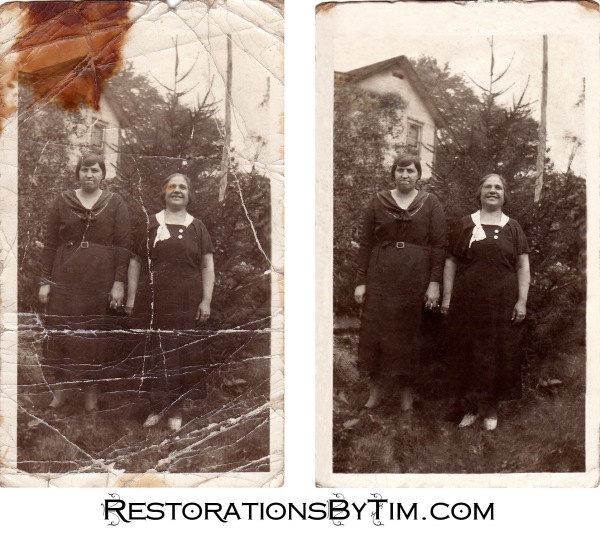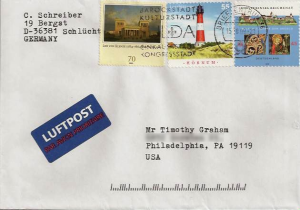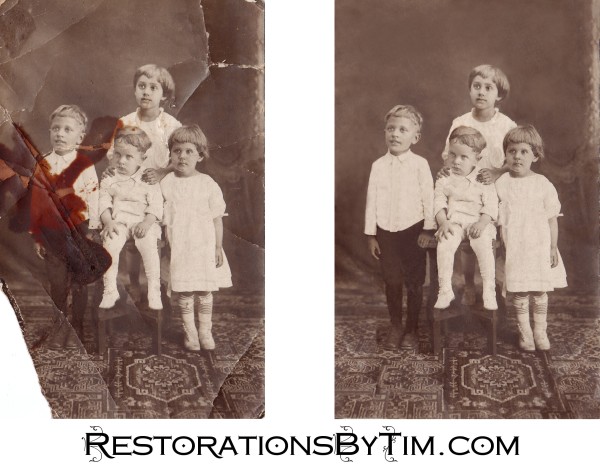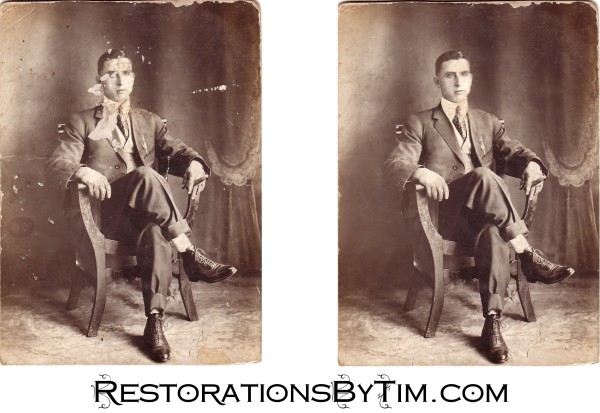Here is one of my better efforts. I’m guessing is that this one got wet in a picture frame and stuck to the glass. If you have a photo stuck to glass, you’re better off leaving it stuck. Don’t try to peel it away. You can scan the photo while it’s still on the glass and send it my way for a quick clean-up. If however, you’ve got hold of a photo that’s had some portions peeled away, not all is lost. With some time and imagination, I can set it right. I’d quote this one in in the upper range: $60 for a major restoration.
Category: Major Restoration
Today’s subject is my great-great-great-grandfather, Peter Staaf. This is my grandmother’s great-grandfather, that is, my mother’s mother’s mother’s mother’s father. Peter was the immigrant ancestor of this line. I found his passenger list on Ancestry.com, which led me to his hometown of Sterbfritz, which is right in the heart of Germany. He left that place and arrived in Baltimore on the sixth of May, 1854, with his wife and daughter, both named Margaret. He settled in Butler County, Western Pennsylvania.
The Staaf family line is the only one I’ve been able to trace back to the motherland, several generations prior to the emigration. This was thanks to a great stroke of luck, in the first place, and then the diligent efforts of a professional genealogist who happened to live right in that area. I learned about Mr. Clemens Schreiber in 2009, when I happened upon this web site that provided his contact information. He happened to live in Schlüchtern, which is a drive of mere minutes from Sterbfritz. Mr. Schreiber happened to charge a very reasonable fee: $7.00 for a family group record. At that price, I purchased the whole Staaf line by mail, going back to 1613. Mr. Schreiber told me that the line of Peter’s wife, Margaret Lotz, went back even further, to about 1450, and asked if I was interested in purchasing that as well. I did not have funds to purchase all of that at the time, but I’m glad to know that information is available. Continue reading

I don’t know a whole lot about my ancestor No. 12, but her image here is a great reminder of why I got into this business. It is the quintessential photo restoration project. I have exactly one picture of this woman, and guess what: It’s wrecked. Wrecked, but salvageable. A little digtial wizardry and voila! Virtually good as new!
Well, enough about me. Let’s get to our subject. Meet Angeline Scaletta, or Aunt Angel, as my grandmother called her (pronounced AHN-jel). She is standing at right in the above photo, next to my great-grandmother, Katherine (Balmer) Scaletti. She was the older sister to my great-grandfather, Antonino Rocco Scaletti. According to civil birth records, she was born in Trabia, Sicily, on April 15, 1884. That made her a full nine years older than Nino, who was born in 1893. Nino also had two older brothers: Giuseppe, aka Joseph, who was born in 1881, and Carmelo, aka Uncle Charly, who was born in 1890.
I’m paying homage this week to the other grandparent that I lost during my youth. A great grandparent. “Great-Grandmom” Johanna Harrison. Continue reading
Here is one of my better efforts, done for a client a few weeks ago. I don’t offer full colorization (yet), but if some portions of your photo have been discolored, I can match the unaffected portions of the image. This restoration took several sessions to complete, so I would ask more than usual. Remember, though, that I do watch a lot of American Pickers, so I’m open to negotiation.
This ceramic photograph was affixed to a gravestone, presumably upon the death of the woman in 1924, and left open to the elements for decades. These are often the only photos of some people that survive, so restoration attempts are in order. I took a close-up photo of it with a handheld digital camera. The most difficult part for me was the dress, believe it or not, and I haven’t yet made any changes to the necklace. I might try some further experiments on it, but I am proud of the result, overall. It was another 10+ hour job. I’d like to attempt a restoration like this for you, although your mileage may vary.
This Polaroid will alter the way I think about pricing my work. It is the most extensive restoration I’ve done to date. Until now, the most extensive restoration I had done was this three-hour job, so I used three hours as my benchmark for this request. These cracks seemed a little more faint, as if they might wipe away a little easier. I also wanted the work, so I gave a quote of two hours at $21 and hour–a $42 job. Oh, how wrong I was. Continue reading
I recreated the left side of this gentleman’s hat entirely from what remained of the right side, although a hat could just as easily have been copied from a similar photo. The latter method might have been preferable had I needed to replace a detailed insignia, but the method I chose ensured similar colors, lighting, etc.
Sometimes a customer may be interested in settling for something passable, rather than perfect, if the customer could thereby save time and money. Although I quoted this request at three hours, I ran into trouble while restoring the standing boy’s left hand, which had been completely obscured by a stain. Instead of piling on the hours, I simply copied the sitting boy’s left hand over and slightly modified it slightly. Although, I spent about four hours on this request, I’d charge the quoted three hours and leave the customer with the option of buying more time to work on the hand. One possible solution would be to photograph a model’s hand and then replace the boy’s hand with that of the model.
It will often be impossible to perform these requests convincingly. In this case, there happened to remain enough visual guides for me to imagine where things ought to be. The task was painstaking. I spent a good couple hours rebuilding this gentleman’s eye, ear, lapel, and collar, among making numerous other repairs.















Recent Comments